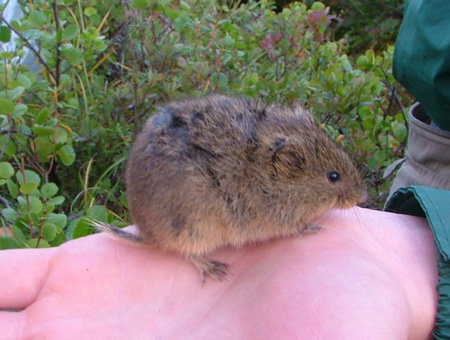Friday, December 30, 2011
Tuesday, December 13, 2011
Students Participate in Scientific Studies
Students Participate in Scientific Studies
| ||
| |||||
Related articles
- Application Period for Summer Seasonal Positions (alaska-outdoors.blogspot.com)
- Sea Wolf Adventures Wins National Accessibility Award (alaska-outdoors.blogspot.com)
- Public Invited to Participate in Initial Scoping for Park Headquarters Utilidor Replacement (alaska-outdoors.blogspot.com)

Saturday, December 3, 2011
Application Period for Summer Seasonal Positions
Sitka National Historical Park (November 22, 2011) - Are you interested in working for the National Park Service this summer?Sitka National Historical Park will be hiring seasonal park rangers, park guides, and one seasonal law enforcement ranger.
Please visit the federal jobs website at http://www.usajobs.gov/ to learn how to apply for Sitka National Historical Park's available positions.Summer positions will be announced beginning November 23rd.The open period for applications will last three weeks from the date of the announcement.
Each job announcement on USAJOBS contains complete information about duties, qualifications and evaluations, benefits, and detailed instructions on how to apply. Be sure to read each announcement fully and carefully. Contact information for additional questions about the job are also listed in each announcement.
All federal job vacancy announcements, including permanent, temporary, and seasonal National Park Service jobs in Sitka National Historical Park, are advertised on www.usajobs.gov-the official job site of the United States federal government. Browse, search, and apply for jobs online; search by keyword, job title, occupation (e.g., "park ranger"), location (e.g., "USA," "Alaska," "Sitka" or "Sitka National Historical Park"), type of work, pay, and more.
For more information or to obtain a copy of the job announcements, please stop by the Administration Office at 103 Monastery Street or the Visitor Center at 106 Metlakatla or call 907-747-0110.Inquiries may also be directed to becky_latanich@nps.gov.
Related articles
- New Temporary Exhibits at Sitka National Historical Park (alaska-outdoors.blogspot.com)
- National Public Lands Day Celebrated September 24, 2011 (alaska-outdoors.blogspot.com)

Sea Wolf Adventures Wins National Accessibility Award
 |
| Image via Wikipedia |
For many years, Kimberly Owen, of Sea Wolf Adventures, has quietly (and passionately) developed special equipment and staff skills to enable a broad range of park visitors, in particular those with mobility challenges, to experience, first hand, both traditional small vessel sightseeing as well as off-vessel wilderness activities such as kayaking and shore excursions. This included major modifications to her 97 ft. converted WWII minesweeper to accommodate mobility impaired passengers, and systems implemented to facilitate wilderness adventure activities. The modifications include widened passage ways, lifts to all decks, and wheelchair-accessible cabins and public areas.
In recognition of this effort, Glacier Bay National Park and Preserve nominated Sea Wolf Adventures for the award, and is very pleased to announce that Kimberly has been selected as the national winner. Kimberly was presented her at award at a ceremony in Washington DC on November 3 by Julie Washburn, NPS Associate Director for Interpretation and Education.
Related articles
- Public Invited to Participate in Initial Scoping for Park Headquarters Utilidor Replacement (alaska-outdoors.blogspot.com)
- NPS Invites Public to Meetings on Draft Denali Park Road Vehicle Management Plan (alaska-outdoors.blogspot.com)
- Comment Period for Environmental Assessment on Climbing Allocation for Mount McKinley Extended (alaska-outdoors.blogspot.com)
- Kantishna Burn Pile Notice (alaska-outdoors.blogspot.com)
- Nps Seeks Input on Environmental Assessment for Chilton Creek Area Boat Ramp and Parking (missourioutdoors.blogspot.com)

Friday, December 2, 2011
Bears of North America Evening Program and Book Signing
 |
| Image via Wikipedia |
Sitka National Historical Park (November 25, 2011) -Please join Matthias Breiter, author of Bears-- A Year in the Life (2006) and The Bears of Katmai (2008) for his evening program, "Bears of North America." The program will take place on Thursday, December 8th at 7:00 p.m. at the Sitka National Historical Park Visitor Center Theater.
Breiter, who is presently finishing his Ph.D. thesis on aggression in bears, has been a frequent lecturer at zoos and also the Smithsonian Institution about bear biology and bear conservation. He has worked as a cinematographer with the National Geographic Society, Discovery Channel and several other TV producers on documentaries both on polar bears and brown bears.Breiter is deeply involved with conservation efforts involving the American and Canadian Arctic and Subarctic and is a founding member and fellow of the International League of Conservation Photographers (ILCP).
A book signing will immediately follow the presentation. His four publications, Inside Passage ($39.95), Wild Alaska ($39.95), and Bears-- A Year in the Life ($24.95) and The Bears of Katmai (19.95) will be available for purchase through the park's Cooperating Association-Alaska Geographic.
Related articles
- National Public Lands Day Celebrated September 24, 2011 (alaska-outdoors.blogspot.com)
- New Temporary Exhibits at Sitka National Historical Park (alaska-outdoors.blogspot.com)

Thursday, December 1, 2011
2012 Denali Bus and Campground Reservations Available Beginning December 1
 |
| Image via Wikipedia |
Approximately 65% of the shuttle bus seats and 100% of the campsites in the Riley Creek, Savage River, Teklanika River, and Wonder Lake campgrounds can be reserved in advance. The remaining tickets are made available for advance or walk-in reservations two days before the travel date. The Riley Creek, Savage River, and Teklanika River Campgrounds are open for tents and RVs, but the Wonder Lake Campground is tents only. Hookups are not available in any of the park's campgrounds.
The shuttle bus system is designed to provide transportation into the heart of Denali National Park and Preserve for visitors who wish to view the park's scenery and wildlife, access campgrounds, go hiking for the day, or take an overnight trip into the park's backcountry. Drivers will answer questions and help visitors spot wildlife. The shuttle bus system will operate from Sunday, May 20 through Thursday, September 13, 2012, weather permitting.
2012 shuttle bus prices for an adult single trip fare:
Toklat Eielson Visitor Center Wonder Lake Kantishna
$26.75 $34.00 $46.00 $50.00
The camper bus fare (for campers in park campgrounds or with backcountry permits) is $34.00. On all buses, children 14 and under ride free and young adults age 15-17 ride for half price.
A maximum of eight shuttle bus seats may be requested with each reservation, and ages are required as age discounts may apply. Please provide alternate dates and times when possible.
Phone reservations can be made by calling (800) 622-7275 nationwide or (907) 272-7275 for international callers between 7:00 am - 5:00 pm (Arizona time). The web address for on-line reservations is www.reservedenali.com. Forms for fax reservations are also posted at www.reservedenali.com. The completed forms should be faxed to (602) 331-5258. Mail-in reservation requests should be sent to:
ARAMARK /Joint Venture Reservations
2445 West Dunlap Avenue
Phoenix, AZ 85021
Related articles
- Deanli Park Road Open To Mile 13 (alaska-outdoors.blogspot.com)
- Tangle Lakes Campground Renovation Update (alaska-outdoors.blogspot.com)
- Fall Harvest Festival and open house planned Oct. 15 at Washington State Park (missourioutdoors.blogspot.com)
- Mark Twain National Forest Looking For Recreation Site Concessionaires (missourioutdoors.blogspot.com)

Saturday, November 26, 2011
Copper River Highway closed indefinitely at mile 36 due to safety concerns
The Alaska Department of Transportation & Public Facilities (ADOT&PF) has indefinitely closed the Copper River Highway at mile 36 due to safety concerns at Bridge No. 339. The closure will last until the bridge is replaced.
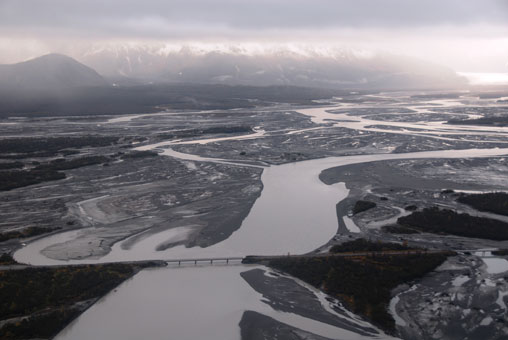
The 56-mile Copper River Highway is located near Cordova and ends at the Million Dollar Bridge. The road, frequented by hunters and recreationists, leads to vast areas of proposed resource development.
Bridge No. 339 is one of eleven bridges crossing the Copper River Delta. Naturally occurring changes to the flow of water between channels across the delta led to a dramatic increase in the amount of water running under the bridge. Due to the increased amount of water, 50 ft of “scour”, or erosion, was observed at the bridge in 2011. The scour resulted in a lowering of the channel bottom that compromised the structure of the bridge and necessitated the closure.
Bridge No. 339 was constructed in 1977. Based upon the channel configurations at that time, bridge designers estimated that water under the bridge would flow at 18,500 cubic feet per second (cfs). During the summer of 2011, U.S. Geological Survey (USGS) hydrologists measured the water flow to exceed 85,000 cfs.
Channel and flow distribution changes are a natural part of deltaic river systems. The adverse effects of these changes on Bridge No. 339 was first noted in 2009, when the bridge began receiving a greater portion of the total Copper River flow than its neighboring bridges. In 2010, ADOT&PF and the USGS began a comprehensive monitoring program at the bridge that included frequent on-site inspections and the use of bridge sensors that enabled remote observation of the bridge.
ADOT&PF received funding this fall to start the design phase of a replacement bridge; the design phase will progress through 2013 with agency permitting in 2014. Pending the availability of construction funds, the construction project could begin as early as 2015.

Friday, November 25, 2011
Cutting your own Christmas tree
 |
| Image via Wikipedia |
Get A Fresh Spruce, have a happy holiday...
It's that time of year when families are venturing out through the snow and into the woods to search for that perfect Christmas tree. The Chugach National Forest has just the place to find that magical tree free of charge, if you follow some straightforward guidelines:
- All areas of the Chugach National Forest on the Kenai Peninsula are open, with the exceptions of Portage Valley and Turnagain Pass. The Portage closure* extends from the Seward Highway to Portage Lake. The Turnagain Pass closure* extends from just north of the Turnagain Pass Rest Area (at MP 57 from Anchorage; MP 70 from Seward) to the Bertha Creek Campground (MP 61.5 from Anchorage; MP 65.5 from Seward).
- Each household or organization is allowed one tree from the Forest. No permits are required to cut trees for personal use. However, permits are required to cut trees for commercial purposes. The free trees cannot be sold, bartered or used in any commercial-type exchange for goods.
- Be certain you are on land managed by the Forest Service.
- Cut trees at least 150 yards (450 feet) away from main roads, picnic and campground units, administrative facilities, trails, and bodies of water.
- Do not fell trees into streams or other bodies of water. Cut trees as close to the ground as possible.
- Do not lop off the tops of trees higher than 20 feet in order to get the good parts.
- Follow off-road zoning regulations. Select your tree thoughtfully, to avoid unsightly bare spots.
To receive further information contact one of our offices:
- Anchorage office at (907) 743-9500
- Seward District office at (907) 224-3374
- Glacier District office at (907) 783-3242.
Related articles
- Eastern Kenai Peninsula slash pile burning (alaska-outdoors.blogspot.com)

Wednesday, November 9, 2011
BLM-Alaska Resource Advisory Council meets in Fairbanks
 Image via Wikipedia
Image via Wikipedia
Anchorage -- The Bureau of Land Management's Alaska Resource Advisory Council will meet Nov. 29 and 30 in Fairbanks at the Fairbanks Princess Riverside Lodge, 4477 Pikes Landing Road. The meeting begins at 9:30 a.m. on Nov. 29th and will recess at 4:30 p.m. The Council will accept public comment from 3:30 p.m. – 4:30 p.m. on Nov. 29. Written comments are also welcome. On Nov. 30, the meeting begins at 9:00 a.m. and will adjourn at 3:30 p.m. The council’s agenda includes invasive weeds program, commercial activity policy (cabins/temporary facilities), land use plan updates, NPR-A oil and gas lease sale, land conveyance report and other topics of interest to the RAC.
For additional information, please go to: http://www.blm.gov/ak.
Related articles
- BLM-Alaska Releases Draft Determination of NEPA Adequacy and Map for the NPR-A Lease Sale (alaska-outdoors.blogspot.com)

Thursday, November 3, 2011
Alaska Peninsula, Kodiak and the Aleutians Wildlife Viewing
FROM ADF&G
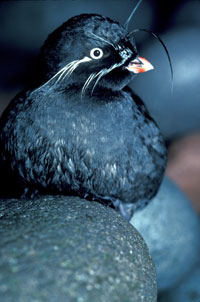
Whiskered auklet
This section offers wildlife viewing highlights along the Alaska State Marine Highway's Southwestern route with the exception of the Pribilof Islands, which are only accessible by commercial air service. The ferry route provides regular public transportation from April through October for eight remote Alaska Peninsula and Aleutian Islands communities, from Chignik to Unalaska, with additional stops in Homer, Kodiak and Port Lions.
For residents, the twice-monthly ferry trips, serviced by the ferry M/V Tustumena, offer opportunities for taking care of necessities such as transporting vehicles and gear, grocery shopping or medical care. For wildlife watchers, the journey can be an experience of a lifetime, with opportunities to view little-seen animals amid dramatic natural backdrops. Birders come here from around the world to add unique species to their "life lists."
No spur-of-the-moment jaunt, this nearly 2,000-mile trip takes at least six days, and tickets cost about as much as cross-country plane fare. Because the Tustumena runs infrequently, and accommodations along the way are few, anything beyond a brief stop in most communities involves careful advance planning.
Viewing Locations
Because the Aleutian Chain trip passes along a significant slice of the remote and widespread Alaska Maritime Wildlife Refuge, a refuge naturalist rides the state ferry from Homer to Kodiak and Unalaska in the summer to present educational programs and answer questions.
Refuge experts suggest visiting June through August, when marine birds and mammals are coming ashore to breed and raise young. Fall visitors could be in for stormier seas, but will see a variety of arriving, over-wintering birds. Early spring is the best time to catch whale migrations through Shelikof Strait.
The Pribilof Islands, which lie 200 miles north of Unalaska in the middle of the Bering Sea, are popular with birdwatchers. Over 240 species of birds have been identified there; an estimated two million seabirds nest there annually.
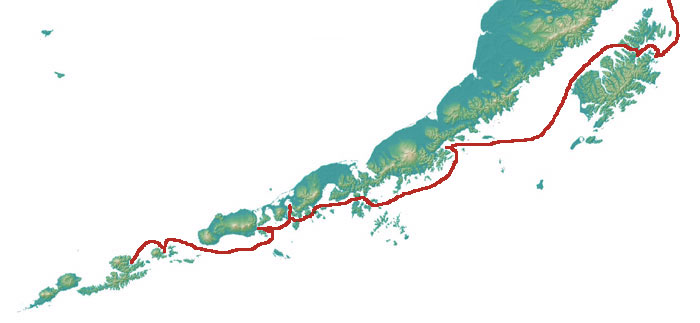

Wednesday, November 2, 2011
Deanli Park Road Open To Mile 13
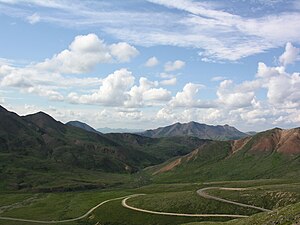 Image via WikipediaThe contractors working on the culvert replacement project have finished for the season, and the Denali Park Road is now open to the Savage River Campground at Mile 13, weather permitting. The road will close at park headquarters (Mile 3) when the next snowfall occurs. The road is closed to traffic west of the campground due to icy and snowy conditions on sections of the road, particularly the portion that winds down to the Savage River. Visitors are advised to call ahead for weather and road information, as conditions can change rapidly.
Image via WikipediaThe contractors working on the culvert replacement project have finished for the season, and the Denali Park Road is now open to the Savage River Campground at Mile 13, weather permitting. The road will close at park headquarters (Mile 3) when the next snowfall occurs. The road is closed to traffic west of the campground due to icy and snowy conditions on sections of the road, particularly the portion that winds down to the Savage River. Visitors are advised to call ahead for weather and road information, as conditions can change rapidly. There will be vault toilets available for visitors at the Mountain Vista Trailhead parking area. All other facilities west of headquarters, such as campgrounds and restrooms, are closed. The Murie Science and Learning Center is open daily from 9:00 a.m. - 4:00 p.m. to provide park information and backcountry permits.
The Bear Loop of the Riley Creek Campground at Mile 0.2 is open for camping, but the water is off for the season. A vault toilet is available for campers, and water can be obtained at the Murie Science and Learning Center. Gas, food service and lodging are available year-round in the communities of Healy and Cantwell.
Denali National Park and Preserve collects an entrance fee year-round. The entrance fee of $10 per person or $20 per vehicle is good for seven days. The majority of the money collected remains in the park to be used for projects to improve visitor services and facilities. Interagency Federal Recreation Passes such as the Annual, Senior, and Access Pass, and the Denali Annual Pass are also valid for entry into the park. Visitors can pay entrance fees at the Murie Science and Learning Center.
Related articles
- Denali Park Road open to Mile 30 through September (alaska-outdoors.blogspot.com)
- NPS Invites Public to Meetings on Draft Denali Park Road Vehicle Management Plan (alaska-outdoors.blogspot.com)
- Adventures By Disney - Alaska (disneymemoriestravel.wordpress.com)
- Comment Period Extended for Draft Denali Park Road Vehicle Management Plan (alaska-outdoors.blogspot.com)
- Denali Seeks Input on Proposal to Simplify Entrance Fees (alaska-outdoors.blogspot.com)

Firearm Maintenance
FROM ADF&G
Home Care
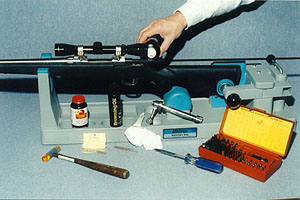 A good cleaning kit contains: 1-piece rod, bore guide, jag tip, brass brush, cotton patches, firearm screw driver kit, and brass hammer.
A cleaning kit should contain a one-piece cleaning rod with a rotating handle. For patches, use a pointed jag rather than a loop. In the barrel, the tight-fitting jag and patch combination will remove more fouling than the loose fitting loop and patch. A kit should also have a bronze or brass brush, the same size as the bore. Along with a rod, jag, and brush, your kit needs lots of correctly sized cotton patches, as well as a bottle of bore solvent. (Shooter’s Choice and Hoppe’s Copper Solvent are examples that will remove copper and powder fouling.) Finally, a thin film of good lubricant such as Browning Gun Oil or Tetra Gun Oil is required to protect your gun after cleaning.
A good cleaning kit contains: 1-piece rod, bore guide, jag tip, brass brush, cotton patches, firearm screw driver kit, and brass hammer.
A cleaning kit should contain a one-piece cleaning rod with a rotating handle. For patches, use a pointed jag rather than a loop. In the barrel, the tight-fitting jag and patch combination will remove more fouling than the loose fitting loop and patch. A kit should also have a bronze or brass brush, the same size as the bore. Along with a rod, jag, and brush, your kit needs lots of correctly sized cotton patches, as well as a bottle of bore solvent. (Shooter’s Choice and Hoppe’s Copper Solvent are examples that will remove copper and powder fouling.) Finally, a thin film of good lubricant such as Browning Gun Oil or Tetra Gun Oil is required to protect your gun after cleaning.
Cleaning a rifle from the muzzle end may cause damage to your firearm.
To clean your bolt action rifle, first remove the bolt from the receiver. Place the jag tip in the cleaning rod. Take a cloth patch and dip it in the solvent. Center the wet patch on the jag. Run the patch-tipped jag through the barrel from the back of the barrel where you removed the bolt. (Note: Never clean a rifle from the muzzle end unless you absolutely have to, such as with a lever, pump, or semi-automatic. You run the risk of damaging the rifling at the muzzle, and this may cause a loss of accuracy.) As the jag clears the end of the barrel, the patch will fall off. Remove the rod and repeat the process.
Replace the jag tip with the brush and push it back and forth in the barrel at least 10 times. This will help loosen the copper fouling. Remember to keep your hand on the handle so the rod can rotate with the rifling.
Next, replace the brush with the jag and a clean, dry patch. Then push the rod through the bore of the rifle. Repeat this process using several patches until the cotton patch comes out clean. Lightly oil a patch — only a drop or two of lubricant — and place it on the jag. Run a lubricated patch through the bore. This will protect the inside of the barrel until you are ready to practice again or go hunting.
Finally, use a lightly oiled patch or cloth to wipe down all the outside metal surfaces of the firearm. If the firearm has been used in the snow, rain, or near salt water, then take the barrel and action from the stock and wipe the internal metal parts with an oiled patch.
Field Care
Alaska is a land of weather extremes. If you hunt the coastal areas, your firearms will be exposed to salt spray and high humidity and may rust in a matter of hours — even if they are made of stainless steel. If the internal parts, such as the trigger mechanism or firing pin, are exposed to salt water and humidity, they may not work when you need them. If you hunt in extremely cold temperatures, your firearm may not fire unless all grease and oil have been carefully removed. These difficult weather conditions make it essential to keep your firearm in good working order.
Pack a small cleaning kit when you hunt.
To maintain your firearms when you hunt, always pack a small container of light gun oil or lubricant, compact cleaning rod with a jag or loop, and plenty of cotton patches. Remember to take screwdrivers, Allen, or Torx wrenches that fit the screws on your gun, scope bases, and rings.
Finally, pack a small roll of black electrician’s tape to cover the muzzle when you are hunting to keep out dirt, debris, and rain.
Clean your rifle after every practice and hunting trip.
After hunting each day, wipe all the metal surfaces of your gun with a patch containing oil or other lubricant. If you have been hunting in the rain or snow, you should also run an oiled patch through the barrel. If it rains or your gun falls into water, you should remove the barrel and action from the stock and carefully wipe dry and then lubricate all metal surfaces.
Temperatures will affect your rifle. Never store your rifle inside a warm cabin or tent at night, or overnight in a waterproof gun case. In either situation condensation may form on your firearm, causing rust, or fog your scope. The best place to store your firearm in hunting camp is outside your cabin or tent, under a protective cover from rain or snow.

A good cleaning kit contains: 1-piece rod, bore guide, jag tip, brass brush, cotton patches, firearm screw driver kit, and brass hammer.

Labels:
Bolt action,
Brush,
Cleanliness,
Firearm,
Fouling,
Gun,
Gun barrel,
Solvent
Location:
Alaska, USA
PARK CELEBRATES NATIVE AMERICAN HERITAGE MONTH
 Image via Wikipedia
Image via Wikipedia
Sitka National Historical Park- Sitka National Historical Park will offer events and activities this November in honor of Native American
Heritage Month.
Fun with Formline Youth Art Class
Friday, November 4th
Noted artists Charlie Skultka and Tommy Joseph will host a Formline Art Class after school from 3:30 p.m. - 4:30 p.m at the visitor center.Youth will work with the artists to create and decorate a paper bentwood box, paper totem pole, or paper Eagle or Raven medallion.Participants are encouraged to donate their completed project for temporary display in the "Fun with Formline" art exhibit.To participate in the class, please RSVP to Kelly Smitherman at e-mail us or call 747-0134 before November 3rd.
Salmon Bake
Sunday, November 20th
Please join park staff for a traditional salmon bake and community potluck from 1:00 - 3:00 p.m.Haida artist Charlie Skultka will prepare salmon in a beachside pit.We will provide the salmon, but please bring something to share! Please help us by sending an RSVP to Kelly Smitherman at e-mail us or call 747-0134 before November 18th.
Film Series
Saturday, November 12th and November 26th
Interested in learning about America's diverse indigenous peoples?Come join us for a series of short films from national park units that commemorate the history and traditions of Native American and Alaska Native peoples.
November 12th
9:30 a.m.Pipestone (An Unbroken Legacy)
10:00 a.m. Trail of Tears
12:30 p.m. Destiny at Dawn (Loss & Victory on the Washita)
2:00 p.m.Breath of Life (Salinas Valley Pueblo)
November 26th
9:30 a.m.Gila Cliff Dwellings National Monument
10:00 a.m. Canyon Voices (Modern day Navajo occupants of Canyon De Chelly)
12:30 p.m. Their Shots Quit Coming (Battle of Little Big Horn)
2:00p.m. His Spirit is Looking out from the Cave(Ice Age Archeology from On Your Knees Cave on Price of Wales)
Related articles
- National Public Lands Day Celebrated September 24, 2011 (alaska-outdoors.blogspot.com)
- New Temporary Exhibits at Sitka National Historical Park (alaska-outdoors.blogspot.com)

Labels:
Alaska Native,
Ethnicity,
Native American Heritage Month,
Native Americans in the United States,
November,
Sitka National Historical Park,
United States
Location:
Sitka, AK, USA
Subscribe to:
Posts (Atom)
